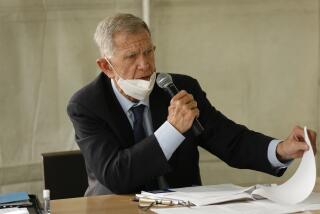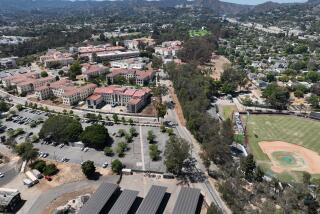A judge commandeers L.A.’s City Hall in his campaign to curb homelessness

- Share via
With deaths from COVID-19 spiking in California, it might seem unsafe for nearly three dozen politicians, lawyers and activists to pile into a room for a legal hearing about homelessness.
But on Friday, U.S. District Judge David O. Carter sat in the Los Angeles City Council chambers, in a chair normally reserved for the president, as each member of the council — in person or via video — provided updates on the progress of their efforts to create more shelter for homeless people now camped near freeways and underpasses.
Temperatures were taken. Masks were worn, but those accessories sometimes slipped to people’s chins, and city employees and lawyers congregated closely in aisles.
“This is a rather historic occasion that the federal court would gather in the City Council chamber,” Carter said. “I hope it’s very positive.”
The setting highlighted the commandeering and theatrical posture Carter has taken in his drive to force concrete action on the county’s homeless crisis. The ostensible purpose was a status conference for an agreement reached by the city and county to find alternate shelter for about 7,000 people living on the sidewalks under freeway overpasses.
Several elected officials complained about delays on a variety of projects across the city. Last month, each member identified encampments from which they wanted to see people moved; in some cases, they told Carter about challenges they were facing. Some council members were frustrated by the bureaucracy of city departments.
For example, Councilman Paul Koretz, who represents parts of the Westside and the San Fernando Valley, described how 94 people were living within 500 feet of a freeway in his district. He expressed concern that the judge’s order and subsequent agreement with the city and county would run afoul of guidance from the Centers for Disease Control and Prevention to not clear encampments unnecessarily for fear of spreading the coronavirus further.
Koretz told Carter there are two parks he’d like to use as sites for modular tiny homes, but the Parks and Recreation Department appeared to be opposed to the idea. The judge asked what he could do about it.
“If you have any way to help lean on those departments, that would be 50 tiny homes in those two combined sites,” Koretz said.
“I don’t think it’s that much to ask.”
Carter’s reports were interspersed with long slide shows of iPhone photos he has taken on his tours of Los Angeles with council members and other advocates for people experiencing homelessness.
Last month, the city set aside $100 million in coronavirus relief funding from the federal government to shelter 6,000 people over the next 18 months. This week, City Administrative Officer Richard Llewellyn offered more details about how to use the money, subject to the approval of the City Council.
A judge ordered officials to provide space in shelters or alternative housing for homeless residents living near freeways. But where will they go?
Among other projects now in the pipeline is the construction of the tiny homes known as “pallet shelters” in two parks near the 170 Freeway in North Hollywood. They would cost a total of about $13 million and house about 270 people.
Llewellyn estimates that as part of the city’s overall plan, there will be 740 interim beds in total, including the pallet shelters. The plan also lays out how the city intends to increase the amount of available rental assistance, asking that another $100 million in federal funding be set aside for this purpose. This would create 3,000 placements for homeless people over the next 18 months, according to city documents.
The plan will also create 850 temporary shelter beds, Llewellyn estimates, and the city is planning to apply for up to $250 million in state money that can be used to purchase vacant buildings and hotels that would house homeless people.
As the updates were reported to Carter, he peppered elected officials and bureaucrats with questions about conditions on the street. He implored them to go out and see what’s happening in their communities and, as he showed photos of skid row and people passed out on the street, he reminded officials that he is prepared to hold the city and county in contempt of court if they don’t make progress on building more shelter for homeless people living near freeways.
“Remember, skid row was created by all of us,” Carter said.
More to Read
Sign up for Essential California
The most important California stories and recommendations in your inbox every morning.
You may occasionally receive promotional content from the Los Angeles Times.








